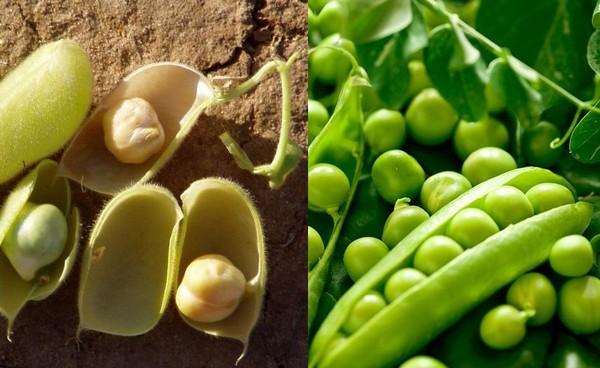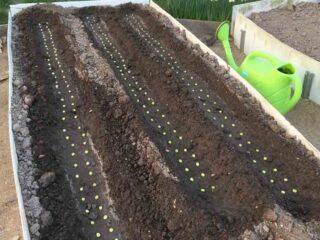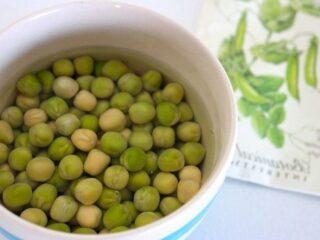Content
Chickpeas, also referred to as Turkish or lamb peas, until recently were perceived by Russian buyers as an oriental exotic product. Today it can be found on the shelves next to “legumes” in many stores. Despite belonging to the same family and some external similarities, chickpeas differ from ordinary peas, from their growing area to their cooking method.

Both types of legumes differ in taste, nutritional value and chemical composition.
What is the difference between peas and chickpeas
Regular peas and chickpeas are representatives of the same family, but the second has a significant superiority over its legume “relative” in terms of qualitative composition. At the same time, it is inferior in terms of protein content.
Appearance
Visually, chickpeas are very different from regular peas. It is larger; the average diameter of a dry pea can reach up to 1 cm. The surface is lumpy and uneven. Dry chickpeas are much harder than peas, and therefore require preparatory manipulations before cooking (long soaking). When ready, its pulp is soft-velvety, pleasant, with a nutty flavor.
The chickpea itself is an annual plant that produces small pods with 2-4 grains inside. It reaches a height of 70 cm, has an erect stem with imparipinnate foliage.
Regular peas also belong to annual plants, but the pods are formed longer, with the number of grains in them from four to ten pieces. The stem is branched, can reach 2.5 m. The leaves are odd-pinnate, complex in shape, with short tendrils at the ends to support the bush in an upright position.
Standard pea grains are round and green in color, but they may vary slightly depending on where they are grown.

Young peas are very tender and soft, they can be eaten raw, unlike chickpeas
Chemical composition
The chemical composition between chickpeas and regular peas also differs. And if we proceed from average indicators, then in the unspoken competition the first one wins. It is famous for its high content of vegetable protein, which makes it perfectly digestible for the body. Chickpeas also contain vitamins A, C, E, K, group B and beta-carotene. Together, they make lamb peas very useful for humans. This product is also rich in macro- and microelements: calcium, magnesium, iron, phosphorus, sodium, potassium, zinc, copper, manganese. A similar list of useful substances can be assigned to ordinary peas, but the difference will be in their quantity.
Vitamins and minerals | Chickpeas | Peas |
A | 15 mcg | 2 mcg |
Vitamin B group | B1 – 0.08 mg, B2 – 0.212 mg, B4 – 95 mg, B5 – 1.58 mg, B6 – 0.535 mg, B9 – 557 mg | B1 – 0.81 mg, B2 – 0.15 mg, B4 – 200 mg, B5 – 2.2 mg, B6 – 0.27 mg, B9 – 16 mg |
C | 4 mcg | 0.8 mcg |
Potassium (K) | 968 mg | 873 mg |
Calcium (Ca) | 193 mg | 115 mg |
Magnesium (Mg) | 126 mg | 107 mg |
Iron (Fe) | 2.6 mg | 6.8 mg |
Calorie content
The calorie content of chickpeas is only 364 kcal. Regular peas are “lighter” in this regard, because they contain only 297 kcal per 100 g. Both types of legumes are valued for the fact that they contain a lot of vegetable protein, while the amount of it according to the BJU table in chickpeas and peas is almost the same - approximately 19-20 g. According to these indicators, they are equated to poultry meat.
The amount of carbohydrates, like proteins, has a slight difference. 100 g of chickpeas contain about 60 g, and peas - 50 g.
The calorie content of chickpeas is higher than peas due to the high content of mono- and polyunsaturated fatty acids Omega-3 and Omega-6. That is why lamb peas are more valuable for adherents of a healthy lifestyle and vegetarians.
Cooking methods and duration
Turkish and regular peas are increasingly used in cooking to prepare both simple and more complex dishes. Legumes are boiled, stewed, made into a side dish and added to soups. Also baked, fried and pureed. Some housewives grind chickpeas and peas into flour to use for baking.
But, regardless of the cooking method, chickpeas and peas definitely need preliminary preparation. For each of these types there is a specific method:
- Peas are very hard, so they need to be soaked for a long time before cooking, often 5-6 hours is enough for the cooking time to be 30-40 minutes.
- Chickpeas also require soaking before cooking, but unlike peas this requires less time as they absorb water, which can affect the final taste of the product. Soaking for 3-4 hours will be optimal, the cooking time after will be 30-40 minutes.

If you cook dry chickpeas, it will take 90 minutes to fully cook, and for dry peas - 60 minutes
Beneficial features
Due to their high protein content, chickpeas and peas are considered one of the healthiest foods. These legumes can replace beef, so many nutritionists recommend including them in the diet. Positive effects on the body also include:
- reduce cholesterol levels and normalize blood pressure;
- regulate the functioning of the digestive tract;
- help improve the condition of bones and muscle tissue;
- control the amount of sugar in the blood;
- have a positive effect on the functioning of the brain and nervous system;
- reduce the risk of excess weight.
Due to the wide range of beneficial properties, chickpeas and peas are used as one of the main components of the therapeutic diet. In addition, these legumes are quite filling, so they do not contribute to overeating.
Harm
Almost all representatives of legumes increase gas formation in the body, so it is undesirable for people with a weak gastrointestinal tract to consume chickpeas and peas, as well as for those who suffer from gout, bladder ulcers, and thrombophlebitis. At the same time, regular peas lead to more bloating, unlike chickpeas.
Turkish and regular peas provoke an increase in uric acid levels and contribute to the accumulation of salts, therefore, with decreased intestinal tone, diseases of the urinary system and kidneys, their use can lead to complications or relapses.
Regions of growth
Chickpeas mainly grow in the tropics and subtropics, and are often found in Australia. Its homeland is Central Asia, but this crop is also grown in India, Eastern Europe and Africa, and even in America. Many Russian gardeners who live in warm regions of the country grow chickpeas on their plots.
Regular peas grow mainly in India, China, and the USA. Canada is considered the leader in the production of dried peas. It is also cultivated on an industrial scale, as well as for personal use, in Russia. The birthplace of this culture is the Middle East.
Which is healthier: peas or chickpeas?
It is impossible to say for sure which is healthier, chickpeas or peas. After all, each product has a different effect. In addition, the effect of usefulness lies in the individual reaction of the human body. This may be due to taste preferences, the state of the gastrointestinal tract, intestinal microflora and other characteristics.
For example, peas lead in the amount of vegetable protein, so they are not recommended for people with poor absorption of the substance and those who have bladder diseases.If we talk about chickpeas, they are less preferable for those who are trying to watch their figure, because their calorie content is higher.

When used correctly, chickpeas and peas are equally healthy, so the choice should be made based on your own preferences
Where are they used?
Legumes have found their use not only in cooking, but also in cosmetology. After all, the beneficial properties of these crops allow you to maintain the proper functioning of many body systems.
In cooking
Turkish and regular types of legumes have recently been ingredients in oriental cuisine, but today they are used to prepare a wide variety of dishes in many countries around the world. They are used to make side dishes and snacks. Legumes are gaining particular popularity in the diet of vegetarians, replacing meat.
The most popular chickpea dish is hummus (a puree of ground chickpeas with spices and oil). Soups also taste good. For example, the first course with tomatoes is prepared with chickpeas, and peas are used to prepare the first course with smoked meats.
In cosmetology
Lovers of natural cosmetics have long mastered the use of legumes. Peas and chickpeas are excellent aids in anti-aging, they improve skin color and reduce inflammation. For this purpose, various masks are used, which are prepared from ground beans with the addition of other components (honey, lemon juice, vegetable oils).
Conclusion
Chickpeas are different from regular peas, but both of these products should definitely be included in the diet. They are good sources of plant protein, iron and many other nutrients. In addition, they have good taste and can be used to prepare a wide variety of dishes.








